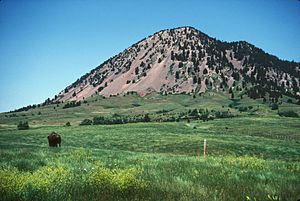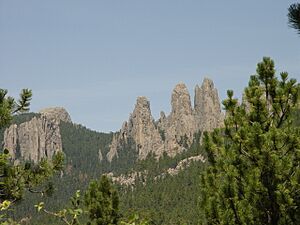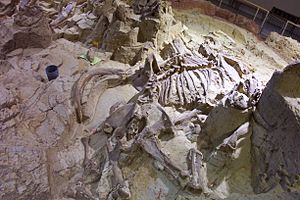List of National Natural Landmarks in South Dakota facts for kids
South Dakota is home to some truly special places called National Natural Landmarks. These are areas that have unique natural features, like amazing rock formations, important wildlife habitats, or cool geological sites. They are recognized because they help us understand the natural history of our planet.
There are 13 National Natural Landmarks in South Dakota. They protect different parts of the state's natural beauty and history.
Contents
South Dakota's Amazing Natural Landmarks
South Dakota's landscapes were shaped by powerful forces over millions of years. These landmarks show us how glaciers, rivers, and erosion created the land we see today.
Ancient River Channels and Wetlands
Some landmarks highlight the power of water, from ancient rivers to important wetlands.
- Ancient River Warren Channel
This landmark in Grant County was formed by the Ancient River Warren. This huge river flowed during the Ice Age, carving out a massive channel. It's a great example of how glaciers and their meltwater changed the land. It is owned by the state and private groups.
- Buffalo Slough
Found in Lake County, Buffalo Slough is a fantastic example of a prairie pothole. These are shallow wetlands formed by glaciers. It has native plants and is an important home for wildlife. The state owns this landmark.
- Cottonwood Slough- Dry Run
In Roberts County, this area is a large, untouched wetland. It includes many potholes, streams, and marshy areas. It's a vital spot for many different kinds of plants and animals. It is owned by the state and private groups.
- Lake Thompson
Located in Kingsbury County, Lake Thompson is a big, natural marsh. It's a super important place for waterfowl, like ducks and geese, to breed and rest. The state owns this beautiful lake.
- Red Lake
This landmark in Brule County is one of the biggest natural prairie pothole lakes left. It's a great example of an untouched wetland ecosystem. The state owns Red Lake.
Unique Rock Formations and Hills
South Dakota also has incredible rock formations and hills that tell stories of the Earth's past.
- Bear Butte
In Meade County, Bear Butte is a cone-shaped rock that rises about 1,300 feet (400 meters) above the flat plains. It's a very important spiritual site for many Native American tribes. It was designated in 1965 and is owned by the state, tribes, and private groups.
- Bijou Hills
The Bijou Hills in Charles Mix County are cool examples of hills left behind by erosion. They are made of soft clays and shales, topped with harder rock. This landmark was recognized in 1976 and is privately owned.
- The Castles
The Castles, found in Harding County, are steep-walled, flat-topped buttes. They stand 200 to 400 feet (60 to 120 meters) above the surrounding prairie. They are part of the Custer National Forest and were designated in 1976.
- Cathedral Spires and Limber Pine Natural Area
This amazing area in Custer County shows how granite rocks can weather and erode in unique ways. It's part of Custer State Park and features tall, spire-like rock formations. It became a landmark in 1976.
- Snake Butte
Located in Jackson County, Snake Butte is special because it shows a rare type of sand calcite deposit. These unique formations are found in only one other place in the world! It was designated in 1967 and is owned by the Oglala Sioux tribe.
Important Wildlife and Fossil Sites
Some landmarks are crucial for protecting wildlife or preserving ancient life.
- Fort Randall Eagle Roost
In Gregory County, this area is a key winter home for bald and golden eagles. These majestic birds gather here during the colder months. It's part of the Missouri National Recreational River and was designated in 1967.
- The Mammoth Site
The Mammoth Site in Fall River County is an incredible place! It's one of the largest collections of mammoth bones ever found in the United States. Scientists learn a lot about these ancient creatures here. It's privately owned and became a landmark in 1980.
- Sica Hollow
Found in Marshall County, Sica Hollow is a state park that shows many different aspects of natural history. It's a place where you can explore forests, wetlands, and unique geological features. It was designated in 1967.
These National Natural Landmarks help protect and preserve the amazing natural heritage of South Dakota for everyone to enjoy and learn from.
Images for kids







